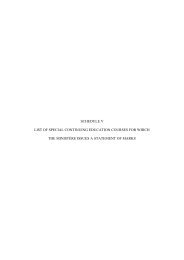Reference Framework for Planning Learning and Evaluation Activities
Reference Framework for Planning Learning and Evaluation Activities
Reference Framework for Planning Learning and Evaluation Activities
You also want an ePaper? Increase the reach of your titles
YUMPU automatically turns print PDFs into web optimized ePapers that Google loves.
Students must meet the predetermined criteria (criterion-referenced interpretation) to obtain the related<br />
marks (dichotomous marking). It is by satisfying a cumulative number of criteria, including the most<br />
important (which are specified) that the student achieves the minimum per<strong>for</strong>mance st<strong>and</strong>ard.<br />
Every competency in the program is evaluated <strong>for</strong> certification purposes. A pass/fail decision is made<br />
on the basis of whether or not the student has achieved the minimum per<strong>for</strong>mance st<strong>and</strong>ard. Programs<br />
are designed in such a way that, in order to receive a Diploma of Vocational Studies or an Attestation<br />
of Vocational Specialization, students must acquire all of the competencies in the program of study in<br />
accordance with job market entry-level requirements.<br />
Using evaluation specifications <strong>for</strong> certification purposes<br />
<strong>Evaluation</strong> specifications <strong>for</strong> certification purposes are developed by specialists. Validation measures<br />
require a group of teachers to evaluate the validity, faithfulness <strong>and</strong> feasibility of the specifications.<br />
Validation methods may vary, but the objective is always the same: to ensure that the application of<br />
criteria <strong>and</strong> weightings allow the teacher to infer the acquisition of a competency.<br />
The use of specifications is essential if educational institutions are to develop examinations in<br />
con<strong>for</strong>mity with compulsory evaluation criteria. The cooperation of teachers who teach the program or<br />
education or evaluation specialists is a simple <strong>and</strong> effective means of ensuring that local examinations<br />
are valid <strong>and</strong> con<strong>for</strong>m to the established criteria or to the pass/fail conditions.<br />
Despite the care taken in the production <strong>and</strong> validation of specifications, a serious weakness may go<br />
undetected <strong>and</strong> result in a false certification. Indeed, if the criteria, weightings <strong>and</strong> minimum<br />
per<strong>for</strong>mance st<strong>and</strong>ard do not result in the recognition of a competent person or, on the contrary, do not<br />
result in the failure of an incompetent person, the educational institution must in<strong>for</strong>m the Ministère,<br />
which will then analyze the difficulty <strong>and</strong> take the necessary corrective measures. It is important to<br />
assure the job market of the value of certification. From the program development stage to the<br />
evaluation of the students’ learning, educational responsibility is shared by the educational institutions<br />
<strong>and</strong> the Ministère.<br />
Key moments <strong>for</strong> recognizing a competency<br />
<strong>Evaluation</strong> <strong>for</strong> certification purposes can take place be<strong>for</strong>e the end of the allotted learning period: the<br />
teacher may recognize that the competency has been acquired <strong>and</strong> evaluate a student <strong>for</strong> certification<br />
purposes be<strong>for</strong>e the rest of the group.<br />
68 <strong>Planning</strong> <strong>Activities</strong> to Help Students Acquire Competencies




